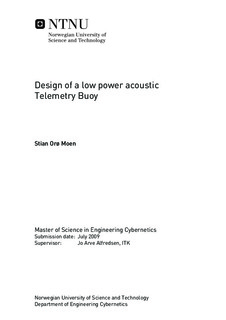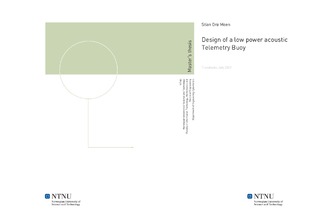| dc.contributor.advisor | Alfredsen, Jo Arve | nb_NO |
| dc.contributor.author | Moen, Stian Orø | nb_NO |
| dc.date.accessioned | 2014-12-19T14:09:00Z | |
| dc.date.available | 2014-12-19T14:09:00Z | |
| dc.date.created | 2014-07-29 | nb_NO |
| dc.date.issued | 2009 | nb_NO |
| dc.identifier | 735628 | nb_NO |
| dc.identifier | ntnudaim:4489 | nb_NO |
| dc.identifier.uri | http://hdl.handle.net/11250/261199 | |
| dc.description.abstract | A telemetry buoy is a standalone device used to receive acoustic pulse-position modulated signals from digital tags attached to fish. The buoy is submerged in the sea and will store any valid signals from tagged fish. The received information typically includes an ID and can include information such as salinity level, depth, temperature, acceleration data and more. The goal of this master thesis was to design and validate a system for a low power telemetry buoy which utilizes digital signal processing. This thesis is a continuance of the work, done by the same author, in the project described in Acoustic telemetry buoy project report [4]. The goal of the previous project was to answer the question ?is it possible to design a low power acoustic telemetry buoy which satisfies at least one year operation and 100 000 stored receptions based on digital signal processing??. The conclusion was that it should be possible to design as system which meets the requirements using the UC3B microcontroller. In addition it is recommended to design an external reception detector to wake up the microcontroller and initiate reception.While the previous project focused on the digital part of the system the master thesis focuses on designing a complete system. The main building blocks that have been designed are Variable gain amplifier Active analogue band pass filter Reception detector MCU with external flashSeveral design concepts have been discussed for each block whereas one complete system prototype have been fully designed, assembled and tested. The system has been proved to work by successfully receiving signals from a standard Thelma fish tag.The prototype has been thoroughly tested and adjustments to improve performance have been suggested. One of the most important criteria is low power consumption and the minimum of one year operation. Current measurements and energy consumption calculations conclude with an expected operation time of 1.51 years. Calculations show that the expected operating time is further increased to 2.21 years if the new Atmel AT32UC3L microcontroller is used in the final design. The design fulfils the other provided requirements with good margin.The final conclusion is therefore that the system design provided in this report, together with the suggested improvements and the UC3L microcontroller, provides Thelma with a good basis for developing the leading standalone ultra low power acoustic telemetry buoy on the market. | nb_NO |
| dc.language | eng | nb_NO |
| dc.publisher | Institutt for teknisk kybernetikk | nb_NO |
| dc.title | Design of a low power acoustic Telemetry Buoy | nb_NO |
| dc.type | Master thesis | nb_NO |
| dc.source.pagenumber | 179 | nb_NO |
| dc.contributor.department | Norges teknisk-naturvitenskapelige universitet, Fakultet for informasjonsteknologi, matematikk og elektroteknikk, Institutt for teknisk kybernetikk | nb_NO |

